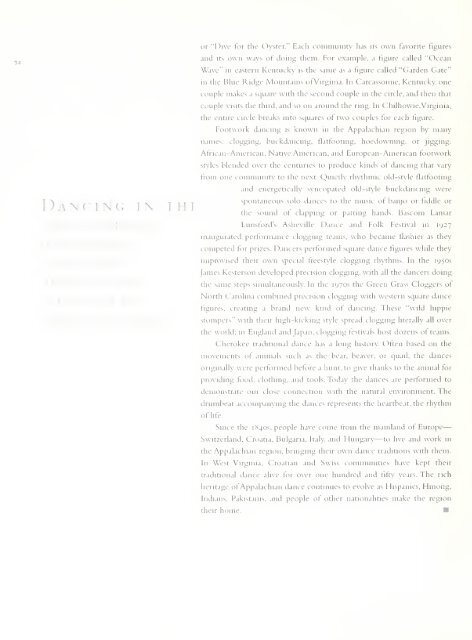SCOTLAND - Smithsonian Digital Repository - Smithsonian Institution
SCOTLAND - Smithsonian Digital Repository - Smithsonian Institution
SCOTLAND - Smithsonian Digital Repository - Smithsonian Institution
Create successful ePaper yourself
Turn your PDF publications into a flip-book with our unique Google optimized e-Paper software.
^,<br />
—<br />
34<br />
or "Dive for the Oyster." Each community has its<br />
own favorite figures<br />
and Its own ways of cloing them. For e.xample, a figure called "Ocean<br />
Wave" in eastern Kentucky is the same as a figure called "Garden Gate"<br />
in the Blue Ridge Mountains otVirginia. In Carcassonne, Kentucky, one<br />
1^ A N C I N G I N T H E<br />
,<br />
couple makes a square with the second couple in the circle, and then that<br />
couple visits the third, and so on around the ring. In Chilhowie, Virginia,<br />
the entire circle breaks into squares of two couples for each figure.<br />
Footwork dancing is known in the Appalachian region by many<br />
names: clogging, buckdancmg, tlatfootmg, hoedowmng, or jigging.<br />
African-American. Native American, and European-American footwork<br />
styles blended over the centuries to produce kinds of dancing that vary<br />
from one community to the ne.xt. Quietly rhythmic old-style flatfooting<br />
and energetically syncopated old-style buckdancing were<br />
„ ^ ^ ^^ -, -^ -r .^ »»T ^T^TTT^ spontaneous solo dances to the music of banjo or fiddle or<br />
the<br />
.<br />
sound<br />
r<br />
ot<br />
,<br />
clapping cir patting<br />
^ ,<br />
hands. ihSascom Lamar<br />
region Ills mtllicnccd<br />
Lunsford"s Asheville Dance and Folk Festival m 1927<br />
inaugurated performance clogging teams, who became flashier as they<br />
UiL ClLXCiUj-UlLIll competed for prizes. Dancers performed square dance figures while they<br />
r ,]-„.,, ,^ , .|-" . improvised their own special freestyle clogging rhythms. In the 1950s<br />
James Kesterson developed precision clogging, with all the dancers doing<br />
AppilklCniiin music, the same steps simultaneously. In the 1970s the Green Grass Cloggers of<br />
11 -1 North Carolina combined precision clogging with western square dance<br />
and the music has .<br />
.<br />
, , ,<br />
. .,_, ,.<br />
\^<br />
. , .<br />
/<br />
hgures, creating a brand new kind ot ciancing. These wild hippie<br />
UltluCUCcd tllC danCllV. stompers" with their high-kicking style spread clogging literally all over<br />
the world; m England and Japan, clogging festivals host dozens ot teams.<br />
Cherokee traditional dance has a long history. Often based on the<br />
movements of animals such as tlie bear, beaver, or tjuail, the dances<br />
originally were performed before a<br />
hunt, to give thanks to the animal tor<br />
providing food, clothing, and tools. Today the dances are performed to<br />
demonstrate our close connection witii the natural environment. The<br />
cirumbeat accompanying the dances represents the heartbeat, the rhythm<br />
of life.<br />
Since the 1840s. people have come t'roni the mainland of Europe<br />
Switzerland, Croatia, Bulgaria, Italy, and Hungary—to live and work in<br />
the Appalachian region, bringing their own dance traditions with them.<br />
In West Virginia, Croatian and Swiss communities have kept their<br />
traditional dance alive for over one hundred and t'lfty years. The rich<br />
heritage of Appalachian dance continues to evolve as Hispanics, Hmong,<br />
Indians, Pakistanis, and people of other nationalities make the region<br />
their home.
















